![]()
![]()
![]()
Use LEFT and RIGHT arrow keys to navigate between flashcards;
Use UP and DOWN arrow keys to flip the card;
H to show hint;
A reads text to speech;
71 Cards in this Set
- Front
- Back
|
Italy in the 15th century comprised over a dozen independent
political units, including the ____________ |
Republic of Florence
|
|
|
Guilds =
|
associations organized by occupation, having important
economic, social, political, and religious functions |
|
|
San Michele:
|
sanctuary of the Florentine guilds
|
|
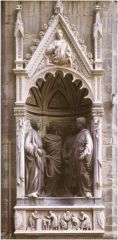
|
Nanni di Banco’s Quattro Coronati- Four “Crowned” Saints
can be compared to Saints at Chartres Cathedral (medieval time) much more realistic very much like roman art |
|
|
________ belonging to the guild of craftsmen who
worked in stone or wood |
Niche at Or San Michele
|
|
|
________ belonging to the guild of craftsmen who
worked in stone or wood |
Niche at Or San Michele
|
|
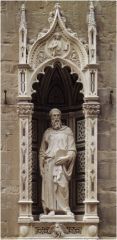
|
Donatello, St. Mark
(also at Or San Michele) Known only by his last name Sad been standing there since the sixteen hundreds and were recently replaced because of erosion Free standing sculpture Very similiar to ancient greek although alot free-er stands on a cusion |
|
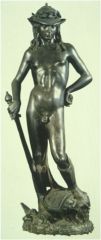
|
Donatello, David
no one knows when it was made could be compared to Doryphorus |
|
|
__________
original location of Donatello’s David (presumably commissioned by Cosimo de’ Medici, unofficial ruler of the city) |
Courtyard of Medici Palace in Florence:
|
|
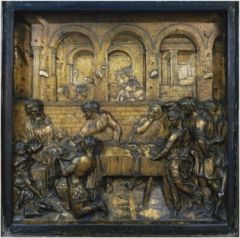
compared to?
|
Donatello, Feast of Herod
Siena Baptismal Font (location of Donatello’s there is a continuous narrative Feast of Herod) Shows good perspective relief can be compared to Andrea Pisano, Baptism of Christ (1330-36) |
|
|
parallel lines
that are perpendicular to the “picture plane” and recede to a single “vanishing point” on the horizon. |
orthogonals:
|
|
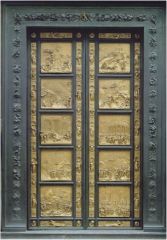
|
Ghiberti, Gates of Paradise
Gates of Paradise (Florentine Baptistery), 1425-52 (15.22), including The Story of Jacob and Esau, ca. 1435 (15.23), and Self-Portrait (barely visible in 15.22) |
|
|
post and lintel
|
Vertical elements are posts
• Horizontal elements are lintels (or beams) |
|
|
Highly developed form of the post and lintel system, which has
evolved into the “Classical Order”: |
posts have become columns
• lintels have become entablatures |
|
|
Diagrams of the Classical Orders:
|
Doric, Ionic, and Corinthian
|
|
|
Arches are composed
|
of wedge-shaped blocks called “voussoirs.”
|
|
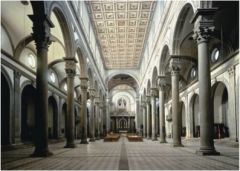
|
Filippo Brunelleschi: Church of San Lorenzo (Florence), begun 1421 (15.7, 15.8)
Brunelleschi, Church of San Lorenzo, Florence (Note: largely financed by Cosimo de’ Medici) Note Brunelleschi’s use of unfluted, monolithic shafts, emulating such Roman buildings as the Pantheon) Interior of San Lorenzo: nave flanked by aisles unfluted columns in the nave but fluted pilasters in the aisles |
|
|
________ diagram showing the
structure of a building at ground level. |
A groundplan is a
|
|
|
________ diagram showing the
structure of a building at ground level. |
A groundplan is a
|
|
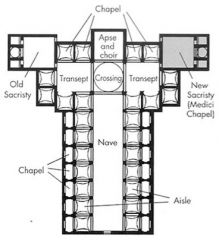
|
Groundplan of San Lorenzo
|
|
|
is a method of cutting and laying
blocks of stone separated from each other by deep joints; blocks are usually rough in texture, as seen here. |
Rustication
|
|
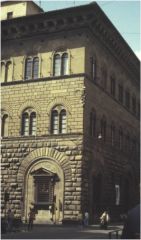
|
Michelozzo, Palazzo Medici
(built for Cosimo de’ Medici) Cornice can be compared to ancient greek Michelozzo: Palazzo Medici-Riccardi (Medici Palace) (Florence), begun 1444 (15.33) |
|

|
Alberti, Palazzo Rucellai
(built for Giovanni Rucellai Alberti 2nd most important in early renn Wrote first imp art book Taught 1 point perspective in his book Abandon roughness and more classical but kept over all composition pilasters between the arches arches are different sizes Three interlocking rings are symbols of Medici Unfinished building Leon Battista Alberti: Palazzo Rucellai (Rucellai Palace) (Florence), 1446-51 (15.32) |
|

|
Masaccio’s Trinity
The holiness or sanctity of the figures is denoted by a halo, usually a gold disk. has Mary and St. John the Evangelist in it haloes foreshortened patrons of the painting probably members of the Lenzi family) Everything is life size Bottom represents a sarcophagus holding a skeleton (first known in history of art) Skeleton was supposed to remind that you are going to die but if you believe ect. Ect. “I used to be what you are, and what I am, you too will be.” good example of vanishing point |
|
|
The study of those aspects
of a work of art that pertain exclusively to its subject, and the ways in which that subject is represented. |
Iconography:
|
|
|
Iconography of the Trinity:
|
• God the Father: elderly bearded man
with blue cloak over reddish shirt. • The Son (Jesus Christ): shown semi-nude and crucified on a cross. • The Holy Spirit (Holy Ghost): appears in the form of a dove. |
|
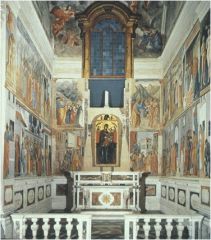
|
The Brancacci Chapel, Florence
(financed by Felice Brancacci) He was probably influences by classical statues |
|
|
__________ an Italian word
meaning “light-dark.” It refers to contrasts of light and shadow in paintings, especially as used to suggest 3-dimensional form. |
chiaroscuro,
|
|
|
__________ an Italian word
meaning “light-dark.” It refers to contrasts of light and shadow in paintings, especially as used to suggest 3-dimensional form. |
chiaroscuro,
|
|
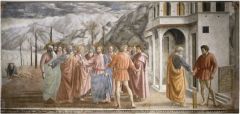
|
The Tribute Money
showing horizon line, orthogonals, and vanishing point. Masaccio: The Tribute Money (Brancacci Chapel, Florence), ca. 1425 (15.15 & 15.17) |
|
|
________ is also suggested by the use of “aerial” or “atmospheric” perspective,
which shows how vision is affected by distance. Things that are further away appear both paler and hazier because of the greater amount of air or atmosphere through which we view them. |
Space
|
|

|
Perugino, Delivery of the Keys
Pietro Perugino: The Delivery of the Keys (Sistine Chapel, Vatican Palace, Rome), 1482 (15.59) Fresco in the Sistine Chapel (Rome): named after Pope Sixtus IV, who built the chapel and commissioned the frescoes. Detail: Christ giving the keys to St. Peter Detail: Perugino’s self-portrait Detail: triumphal arch could be modeled off of the arch of constantine |
|
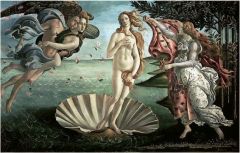
|
Botticelli, Birth of Venus
Probably commissioned by Lorenzo de’ Medici, nicknamed “the Magnificent.” Lorenzo was the grandson of Cosimo de’ Medici and the unofficial ruler of Florence in the late 15th century. Sandro Botticelli: The Birth of Venus, ca. 1485 (15.42) |
|
|
Netherlands =
|
“low lands” or Low Countries:
Holland = Northern Netherlands Belgium = Southern Netherlands |
|
|
Flanders:
|
most important province of the Southern Netherlands
|
|
|
Flemish:
|
adjective pertaining to Flanders
|
|
|
Principal Flemish cities and artists associated with them:
|
Tournai: Campin
Bruges and Ghent: Van Eyck Brussels: Van der Weyden |
|
|
Ars nova:
|
Latin for “New art” —a term sometimes used for early Flemish painting
|
|
|
triptych:
|
a work of art, usually an altarpiece, composed of three separate sections (The prefix tri means “three”; the second part of the word derives from the Greek ptyche, meaning “fold.”)
|
|
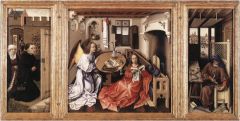
|
Robert Campin: Mérode Triptych/Altarpiece, featuring The Annunciation, ca. 1425-30 (14.9)
Campin, Mérode Altarpiece Triptych with three panels • central panel: Annunciation • left panel or “wing”: Donor Portraits • right panel or “wing”: St. Joseph Donors in Mérode Altarpiece compared with donors in Masaccio’s Trinity |
|
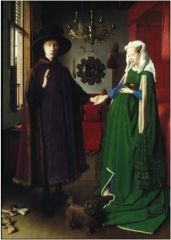
date?
|
Van Eyck, Arnolfini Portrait
Detail: chandelier with a single burning candle Detail: Mrs. Arnolfini Detail of dog: a griffon terrier (symbol of marital fidelity?) Detail of Arnolfini’s wooden shoes (“pattens”) Convex mirror and Van Eyck’s signature (in Latin): Johannes de Eyck fuit hic (“Jan van Eyck was here”), followed by the date 1434 |
|
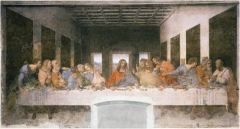
|
Leonardo da Vinci,
Last Supper Painted on the wall of a refectory (dining hall) of a convent in Milan Christ gesturing toward a piece of bread and reaching for a glass of wine (“This is my body. . . . this is my blood”; Matthew 26) |
|
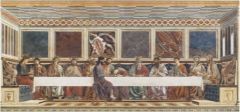
|
Andrea del Castagno, Last Supper (c. 1450)
|
|
|
Frescoes by Raphael
representing the four principal fields of Renaissance learning: |
• Philosophy
• Theology • Poetry (or Literature) • Law |
|
|
Stanza della Segnatura
|
Stanza della Segnatura (“Room of the Signature”) in the Vatican Palace, Rome.
Originally the study of Pope Julius II: nephew of Pope Sixtus IV and patron of Raphael, Michelangelo, and Bramante. |
|
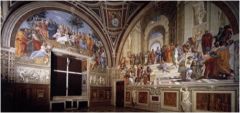
|
Stanza della Segnatura (“Room of the Signature”) in the Vatican Palace, Rome.
Originally the study of Pope Julius II: nephew of Pope Sixtus IV and patron of Raphael, Michelangelo, and Bramante. |
|
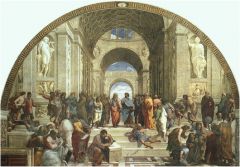
|
The School of Athens (“Philosophy”)
Note: Plato holds a copy of his treatise Timaeus (labeled TIMEO); Aristotle holds a copy of his Ethics (labeled ETICA). Plato and Aristotle: the two most important ancient Greek philosophers Detail: Pythagoras and others, including Pope Julius’s nephew, Francesco Maria della Rovere Detail: “spherical” group of figures, including Bramante—the great High Renaissance architect—in the guise of the philosopher-mathematician Euclid. hidden self portrait of Raphael |
|
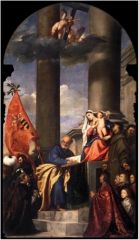
|
Titian, Pesaro Altarpiece
Detail: members of the Pesaro family. Note also the wounds (“stigmata”) of St. Francis. Detail: the youngest member of the Pesaro family |
|

|
Perugino, Delivery of the Keys
Underlying theme is the ides that the authority was given to popes (delivery of the keys) Raphael was a pupil of Perugino Imaginary buildings (temple of Jerusalem) Idea of perfection |
|
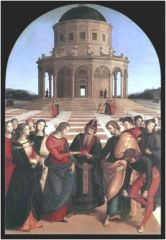
|
Raphael, Marriage of
the Virgin |
|
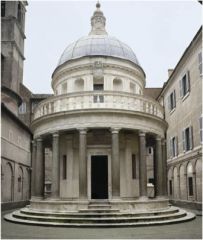
|
Bramante, The Tempietto
First building resembling painting Circular building Tempietto-little temple Set where saint peter met his death (not true) Right beside spanish academy Classical Smooth shafts Doric capitals Spacing and proportions are very important Belongs to the Doric order Note the Doric frieze with triglyphs and metopes |
|
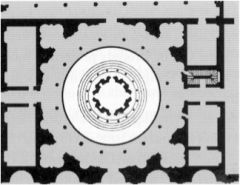
|
The Tempietto and
its intended courtyard |
|
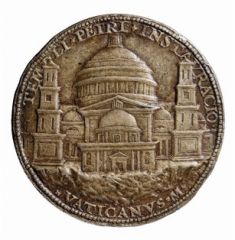
|
Bronze medal of St. Peter’s
designed by Caradosso |
|
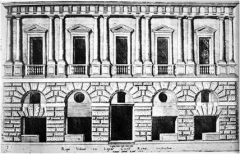
Name?
|
Bramante, Palazzo Caprini (“House of Raphael”)
Note smooth-shafted Doric columns surmounted by a frieze with triglyphs and metopes |
|
|
time line
|
early ren 1400
high ren 1500 late ren 1520-1600 |
|
|
Late Renaissance comprises:
|
(a) Continuation of High Renaissance
(b) Mannerism (c) Other Trends |
|
|
maniera
|
“manner” (in the sense of “style”)
|
|
|
artificioso
|
“artificial” (in the sense of “contrived” or “artful”)
|
|
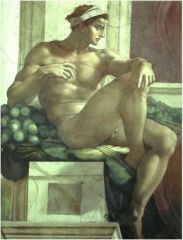
|
Michelangelo, “late” ignudi on the Sistine Ceiling
|
|

|
Parmigianino, Madonna with Long Neck
Parmi came from a place called parma She is posing The hair is unatural Virgin is sexy Dude to the right was probably Isaiah Why so small?? Its very irrational its should be far away but its not Virgin seems so worldly A cross on the urn The patron of this painting was a female (ellena) Looks as if mary looked at the urn and then looked at Jesus The size of the child may suggest the Jesus will one day be an adult he is in a position of maybe the crucifixion?? Comparison to the child of christ to the adult christ Kind of foreshadowing Note: References to the dead, adult Christ are said to be “proleptic”—that is, they anticipate something that will occur in the future. |
|
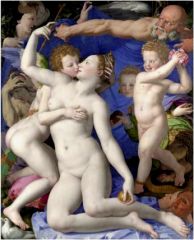
|
Bronzino, Allegory with
Venus and Cupid Allegory was made for the Medici family and then givin to the king of france Allegory symbolic of something Cupid is seen as adolecent |
|
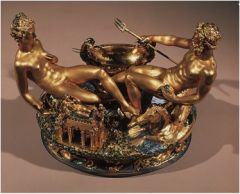
|
Cellini, Saltcellar of Francis I
Cellini traveled to france and resided there for a while It was made for francis the I Sculpture is the only one we have today of Cellini It is a salt shaker The same Ideal body used in this sculpture as the one in Parmigianos Madonna Male figure is Neptune, god of the Sea, who “presides” over the salt Female figure is a goddess of Earth, who “presides” over the pepper Four reclining figures and four half figures could represents with the four winds |
|
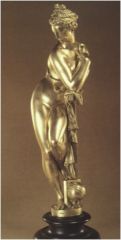
|
Giambologna,
Venus Note: exemplifies the figura serpentinata (“serpentine figure”) |
|
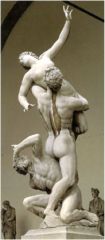
|
Giovanni Bologna:
Giambologna, The Rape of the Sabine Woman Large Rape in the day was just to mean an abduction not todays rape Myth about the founding of the city of rome by soldiers that had no women so the stole them |
|
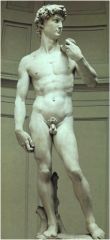
|
Michelangelo, David
Believed that art and philosophy belong together He was taken in by Lorenzo de Medici His time was during the rise of rome and fall of florence Michels david was the 1st collosal statue Was a balance between real and ideal Was at entrance of Palozzo Vecchio Carved out of single rock |
|
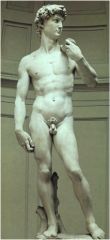
|
Michelangelo, David
Believed that art and philosophy belong together He was taken in by Lorenzo de Medici His time was during the rise of rome and fall of florence |
|

|
Grünewald,
Isenheim Altarpiece Originally the altarpiece of a monastery dedicated to St. Anthony at Isenheim, which included a hospital. Sts. Anthony and Sebastian, celebrated for their healing powers, appear in the wings alot more realistic and crude than other artists |
|
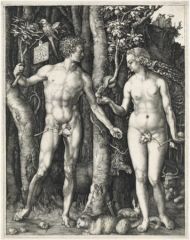
when?
|
Dürer, Adam and Eve
Durer probably most famous german artist Kinda a german renaissance man The animals are there for the intellectuals Each anilmal symbolizes the four different types of people Detail of plaque with signature in Latin (“Albrecht Dürer of Nuremberg made this, 1504”) |
|

|
Dürer, The Four Apostles
(John, Peter, Mark, Paul) can be compared to Nanni di Banco’s Quattro Coronati Detail of text below St. Paul, from Martin Luther’s translation of the Bible |
|

|
Jan Gossaert, Danaë
Note: Gossaert is also nicknamed “Mabuse” after his hometown in the southern Netherlands. He signed this painting across the bottom in a Latin inscription that reads, IOANNES MALBODIVS PINGEBAT 1527 (“Jan of Mabuse Painted [this in] 1527”). achitecture is important |
|
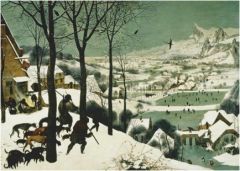
|
Bruegel, Return of the Hunters
(“Winter Landscape”) no classical stye of drapery |

